Touch of Mystery |
||||||||||||||||||||||
 |
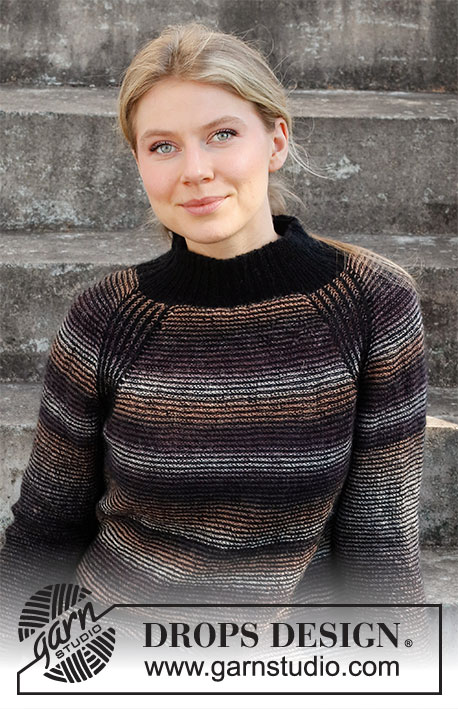 |
|||||||||||||||||||||
Knitted sweater in DROPS Delight and DROPS Alpaca. The piece is worked top down with raglan, stripes and English rib. Sizes S - XXXL.
DROPS 216-37 |
||||||||||||||||||||||
|
------------------------------------------------------- EXPLANATIONS FOR THE PATTERN: ------------------------------------------------------- PATTERN: See diagrams A.1 and A.2. A.1 is worked along the raglan-lines and A.2 down the sides of the body and under the sleeves. STRIPES (in the round): Raglan-lines are worked in English rib as shown in diagram A.2. The other stitches on the yoke are purled from the right side. When you work the body, the piece is turned inside-out and knitted from the wrong side. Alternate stripes of 1 round Alpaca and 1 round Delight. INCREASE TIP (evenly spaced): To work out how to increase evenly, divide the number of stitches to be increased over (e.g. 23 stitches) by the number of increases to be made (e.g. 3) = 7.7. In this example, increase by making 1 yarn over after alternately each 7th and 8th stitch. On the next round, purl the yarn overs twisted to avoid holes. INCREASE TIP-2 (for raglan): Increase on each round of Alpaca (every 2nd round), by making 1 yarn over on each side of each A.1 (= 8 stitches increased on the round). The yarn overs are worked twisted on the next round. The new stitches are purled. INCREASE TIP-3 (sides of body): All increases are worked on a round of Alpaca. Work until there is 1 stitch left before A.2, make 1 yarn over, knit 1, A.2, knit 1, 1 yarn over (= a total of 4 stitches increased on the round). The yarn overs are worked twisted on the next round to avoid holes! The new stitches are knitted. DECREASE TIP (for sleeves): Decrease 1 stitch on each side of A.2 as follows: Work until there are 3 stitches left before A.2, knit 2 together, knit 1, work A.2, knit 1, slip 1 stitch as if to knit, knit 1 and pass the slipped stitch over the knitted stitch. BINDING-OFF TIP: To avoid the bind-off edge being tight you can bind off with a larger size needle. If the edge is still tight, make 1 yarn over after approx. each 4th stitch at the same time as binding off; the yarn overs are bind off as normal stitches. ------------------------------------------------------- START THE PIECE HERE: ------------------------------------------------------- SWEATER – SHORT OVERVIEW OF THE PIECE: The neck and yoke are worked in the round with circular needle, top down from mid back. The yoke is divided for body and sleeves and the body continued inside-out and in the round. The sleeves are worked in the round with double pointed needles, top down. NECK: Cast on 109-121-121-133-133-145 stitches with circular needle size 2.5 mm = US 1,5 and Alpaca. Knit 1 round. The next round is worked as follows: Half back piece: * Purl 2, knit 1 *, work from *-* over 12-15-15-18-18-21 stitches, purl 2. Raglan-line: * Knit 1, purl 1 *, work from *-* over 10 stitches, knit 1. Sleeve: * Purl 2, knit 1 *, work from *-* over 6-6-6-6-6-6 stitches, purl 2. Raglan-line: * Knit 1, purl 1 *, work from *-* over 10 stitches, knit 1. Front piece: * Purl 2, knit 1 *, work from *-* over 21-27-27-33-33-39 stitches, purl 2. Raglan-line: * Knit 1, purl 1 *, work from *-* over 10 stitches, knit 1. Sleeve: * Purl 2, knit 1 *, work from *-* over 6-6-6-6-6-6 stitches, purl 2. Raglan-line: * Knit 1, purl 1 *, work from *-* over 10 stitches, knit 1. Half back piece: * Purl 2, knit 1 *, work from *-* over 12-15-15-18-18-21 stitches. Continue like this for 7 cm = 2¾". Change to circular needle size 3 mm = US 2,5. Insert 1 marker at the beginning of the round, mid-back; the yoke is measured from this marker! YOKE: The next round is worked as follows: Half back piece: Purl 14-17-17-20-20-23 and increase 0-0-1-0-3-3 stitches evenly spaced – read INCREASE TIP. Sleeve: Work A.1 (11 stitches = raglan-line), purl 8-8-8-8-8-8, work A.1 (= raglan-line). Front piece: Purl 23-29-29-35-35-41 and increase 3-5-7-3-11-11 stitches evenly spaced. Sleeve: Work A.1 (raglan-line), purl 8-8-8-8-8-8, work A.1 (= raglan-line). Half back piece: Purl 12-15-15-18-18-21 and increase 0-2-3-0-5-5 stitches evenly spaced = 112-128-132-136-152-164 stitches. Now continue with STRIPES – read description above. REMEMBER THE KNITTING GAUGE! On round 3 in A.1 start to increase to raglan as follows: Increase 1 stitch on each side of each A.1 every 2nd round a total of 26-28-32-36-40-44 times – read INCREASE TIP-2 = 320-352-388-424-472-516 stitches. When A.1 has been worked 1 time in height, continue with A.1a. When the piece measures 19-21-22-24-26-28 cm = 7½"-8¼"-8¾"-9½"-10¼"-11" from the marker (adjust so the next round is worked with Delight), divide the yoke for body and sleeves as follows: Purl 47-52-57-63-70-77 (= half back piece), place the next 68-72-80-88-96-104 stitches on 1 thread for the sleeve, cast on 7 stitches under the sleeve, purl 92-104-114-124-140-154 (= front piece), place the next 68-72-80-88-96-104 stitches on 1 thread for the sleeve, cast on 7 stitches under the sleeve and purl 45-52-57-61-70-77 (= half back piece). BODY: = 198-222-242-262-294-322 stitches. Turn the piece inside-out, so you now knit from the wrong side: Insert 1 marker thread in each side, in the middle stitch cast on under each sleeve. Continue knitting all stitches, apart from the 2 stitches with marker threads which are worked with A.2. When A.2 has been completed 1 time in height, continue with A.2a. When the piece measures 5 cm = 2" from the division, increase 1 stitch on each side of each A.2 – read INCREASE TIP-3. Increase like this every 3 cm = 1⅛" a total of 7 times = 226-250-270-290-322-350 stitches. When the piece measures 30-30-31-31-31-31 cm = 11¾"-11¾"-12¼"-12¼"-12¼"-12¼" from the division (adjust so the next round is worked with Delight) increase evenly spaced as follows: Knit 57-62-67-73-80-87 and increase 0-1-2-2-1-0 stitches, A.2a as before, knit 112-124-134-144-160-174 and increase 1-1-0-2-1-2 stitches, A.2a as before, knit 55-62-67-71-80-87 and increase 1-0-1-0-0-2 stitches = 228-252-273-294-324-354 stitches. Change to circular needle size 2.5 mm = US 1,5 and finish the piece with Alpaca. * Purl 1, knit 2 *, work from *-* over all stitches (A.2a purled). Work this rib for 4 cm = 1½". Bind off with purl from the wrong side – read BINDING-OFF TIP. SLEEVE: Place the 68-72-80-88-96-104 stitches from the thread on the one side of the piece on double pointed needles size 3 mm = US 2,5 and knit up 1 stitch in each of the 7 stitches cast on under the sleeve = 75-79-87-95-103-111 stitches. Turn the piece inside-out, so you now knit from the wrong side. Work A.2 over the middle stitch under the sleeve; the other stitches are knitted in stripes. When A.2 has been worked 1 time in height, continue with A.2a. When the piece measures 3 cm = 1⅛", decrease 1 stitch on each side of A.2a – read DECREASE TIP! Decrease like this every 2½-2½-1½-1½-1-1 cm = 1"-1"1/2"-½"-⅜"-⅜" a total of 12-13-17-20-22-23 times = 51-53-53-55-59-65 stitches. When the sleeve measures 41-40-39-38-36-35 cm = 16⅛"-15¾"-15¼"-15"-14¼"-13¾" from the division, change to double pointed needles size 2.5 mm = US 1,5. Knit 1 round and increase 0-1-1-2-1-1 stitches = 51-54-54-57-60-66 stitches. Finish the sleeve with Alpaca. Work rib (knit 2, purl 1), adjust so the English rib stitch under the sleeve is purled (you are still working from the wrong side). Bind off with purl when the rib measures 4 cm = 1½". Work the other sleeve in the same way. ASSEMBLY: Turn the sweater back to the right side. |
||||||||||||||||||||||
Diagram explanations |
||||||||||||||||||||||
|
||||||||||||||||||||||

|
||||||||||||||||||||||
|
Have you made this or any other of our designs? Tag your pictures in social media with #dropsdesign so we can see them! Do you need help with this pattern?You'll find tutorial videos, a Comments/Questions area and more by visiting the pattern on garnstudio.com. © 1982-2024 DROPS Design A/S. We reserve all rights. This document, including all its sub-sections, has copyrights. Read more about what you can do with our patterns at the bottom of each pattern on our site. |
||||||||||||||||||||||







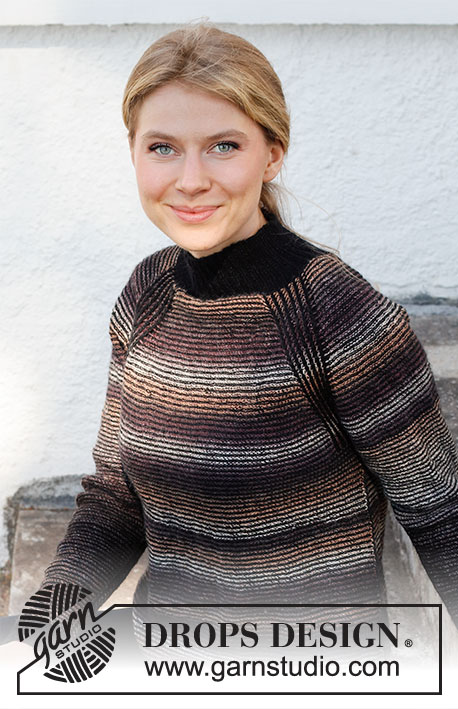



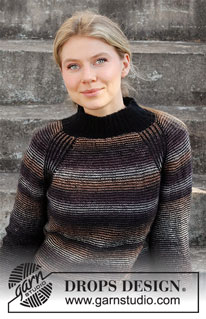

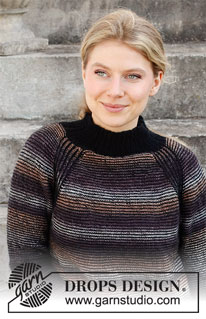
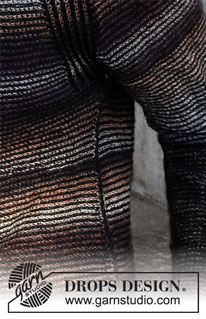




















































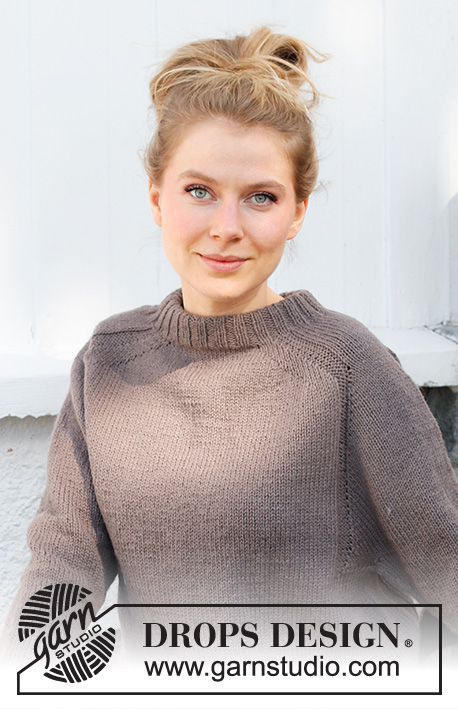






Comments / Questions (7)
Es heißt in der Anleitung, dass die Raglanlinie in Vollpatent gestrickt wird. Und A.1a ist die Strickschrift dafür, richtig? Leider ist A1.a die Strickschrift für ein Halbpatent. Frage ist nun: wie soll die Raglanlinie gestrickt werden? In Vollpatent oder Halbpatent?
25.09.2022 - 13:01DROPS Design answered:
Liebe Claudia, die Raglanlinien werden gestrickt wie im A.1 gezeigt; dann stricken Sie diese Maschen nach der Verteilung wie im A.2 gezeigt. Viel Spaß beim stricken!
26.09.2022 - 09:32Hallo, warum muss man die Abtei wenden und dann Rechts weiterschicken? Welchen Effekt hat das? Kann ich auch bis zum Ende links auf der richtigen Seite Stricken? Vielen Dank für ein Feedback
25.01.2022 - 21:33DROPS Design answered:
Liebe Neige, also mange Strickerinnen stricken lieber mit rechten Maschen als mit nur linken Maschen in der Runde, deshalb wird die Arbeit gewendet und nur mit rechten Maschen gestrickt- wenn Sie immer noch bei Hinreihen /von der Vorderseite stricken, sollen Sie dann A.2 anpassen. Viel Spaß beim stricken!
26.01.2022 - 08:53In der Anleitung ist von Diagramm A.1 und A.2 die Rede. Fehlt das Diagramm in der Anleitung?
11.10.2021 - 08:21DROPS Design answered:
Liebe Frau Ternes, A.1 und A.2 finden Sie neben der Maßskizze, können Sie sie sehen? Viel Spaß beim stricken!
11.10.2021 - 08:44Are the amounts correct? It would appear to me that the black colour is the lesser amount, however in the pattern it is stated as almost twice as much as the colour used in the body and sleeves. Please let me know as I just got started on this and would like to know very soon!
31.12.2020 - 04:12DROPS Design answered:
Dear Lil, you need more of the black yarn = Alpaca than the Delight (stripes colour) since you will require black Alpaca for neck, sleeve edges and bottom edge on sweater. Make sure your tension is correct in both Alpaca and Delight. Happy knitting!
04.01.2021 - 13:31The increase for the raglan. Is it part of the raglan stitches so you increase the English rib part. Or is it either side of the of the A1 section. Thus increasing the sleeve , back front etc. I've increased in the raglan and I think this is wrong.
03.12.2020 - 00:45DROPS Design answered:
Dear Mrs Petto, A.1 is worked at each raglan line and you will increase on either side of A.1 - see RAGLAN, the number of sts in A.1 (= English rib) won't increase, you will increase the number of sts between A.1 = sleeves, front and back piece. Happy knitting!
03.12.2020 - 09:02Hallo, die Raglanschrägen werden im Vollpatent gestrickt, der Rest der Runden in Linksreihen. Durch das Vollpatent erreichen die Raglanschrägen nicht die gleiche Höhe wie die Linksreihen. Ich habe schon versucht, das Vollpatent lockerer zu stricken als das Vorder-/Rückenteil u. die Ärmel. Trotzdem kräuselt sich der Übergang zwischen den Raglanschrägen und dem Vorder- bzw. Rückenteil und den Ärmeln. Wie kann man das vermeiden? Danke und Gruß
28.10.2020 - 08:37DROPS Design answered:
Liebe Christiane, das Vollpatent sollte die gleiche Höhe haben, die Maschen im Vollpatent sind über 2 Reihen gestrickt, und diese 2 Reihen werden überall anders glatt links gestrickt, versuchen Sie die Umschläge vom Vollpattent nicht zu locker zu stricken - beim spannen/1. Waschen kann auch die Arbeit mehr regelmäßig werden. Ihr DROPS Laden hat vielleicht noch einige Tipps für Sie, gerne bekommen Sie dort Hilfe. Viel Spaß beim stricken!
28.10.2020 - 15:22Bonito contraste con el cuello y los puños. Resalta el rostro. Ideal si tienes algo de peso extra.
05.08.2020 - 11:36